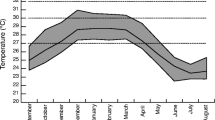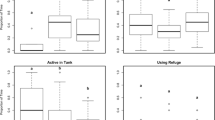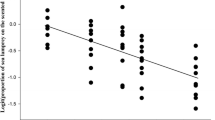Abstract
A wide diversity of fishes possess chemical alarm signalling systems. However, it is not known whether the specific chemicals that act as alarm signals are conserved within most taxonomic groups. In this study we tested whether cross-species responses to chemical alarm signals occurred within salmonid fishes. In separate laboratory experiments, we exposed brook charr (Salvelinus fontinalis), brown trout (Salmo trutta), and rainbow trout (Oncorhynchus mykiss) to chemical alarm signals from each of the three salmonid species and from swordtails (Xiphophorus helleri). In each case, the test species responded with appropriate antipredator behavior to all three salmonids alarm cues, but did not react to swordtail cues. These data suggest that chemical alarm cues are partially conserved within the Family Salmonidae. For each species tested, the intensity of the response was stronger to conspecific alarm cues, than to heterospecific alarm cues, indicating that salmonids could distinguish between chemical cues of conspecifics versus heterospecifics. These results suggest that the chemical(s) that act as the alarm cues may be: 1) identical and that there may be other chemical(s) that allow the test fish to distinguish between conspecifics and heterospecifics, or 2) that the cues that act as signals are not identical, but are similar enough to be recognized.
Similar content being viewed by others
REFERENCES
BEREJIKIAN, B. A., SMITH, R. J. F., TEZAK, E. P., SCHRODER, S. L., and KNUDSEN, C.M. 1999. Chemical alarm signals and complex hatchery rearing habitats affect antipredator behavior and survival of chinook salmon (Oncorhynchus tshawytscha) juveniles. Can. J. Fish. Aquat. Sci. 56:830–838.
BROWN, G. E., and GODIN, J.-G. J. 1997. Anti-predator responses to conspecific and heterospecific skin extracts by threespine sticklebacks: Alarm pheromones revisited. Behaviour 134:1123–1134.
BROWN, G. E., and GODIN, J.-G. J. 1999. Chemical alarm signals in wild Trinidadian guppies (Poecilia reticulata). Can. J. Zool. 77:562–570.
BROWN, G. E., and SMITH, R. J. F. 1997. Conspecific skin extracts elicit anti-predator responses in juvenile rainbow trout (Oncoryhnchus mykiss). Can. J. Zool. 75:1916–1922.
BROWN, G. E., ADRIAN, J. C., SMYTH, E., LEFT, H., and BRENNAN, S. 2000. Ostariophysan alarm pheromones: laboratory and field tests of the functional significance of nitrogen oxides. J. Chem. Ecol. 26:139–154.
CHIVERS, D. P., and SMITH, R. J. F. 1994. Intra-and interspecific avoidance of areas marked with skin extract from brook sticklebacks (Culaea inconstans) in a natural habitat. J. Chem. Ecol. 20:1517–1524.
CHIVERS, D. P., and SMITH, R. J. F. 1998. Chemical alarm signalling in aquatic predator-prey systems: A review and prospectus. Écoscience 5:338–352.
CHIVERS, D. P., PUTTLITZ, M. H., and BLAUSTEIN, A. R. 2000. Chemical alarm signaling by reticulate sculpins, Cottus perplexus. Env. Biol. Fish. 57:347–352.
CHIVERS, D. P., WISENDEN, B. D., and SMITH, R. J. F. 1995. The role of experience in the response of fathead minnows (Pimephales promelas) to skin extract of Iowa darters (Etheostoma exile). Behaviour 132:665–674.
COMMENS, A. M., and MATHIS, A. 1999. Alarm pheromones of rainbow darters: Responses to skin extracts of conspecifics and congeners. J. Fish Biol. 55:1359–1362.
GARCíA, C., ROLAN-ALáVREZ, E., and SáNCHEZ, L. 1992. Alarm reaction and alert state in Gambusia affinis (Pisces, Poecilidae) in response to chemical stimuli from injured conspecifics. J. Ethol. 10:41–46.
HARA, T. J. 1994. The diversity of chemical stimulation in fish olfaction and gustation. Rev. Fish Biol. Fish. 4:1–35.
HUGIE, D. M., THURINGER, P. L., and SMITH, R. J. F. 1991. The response of the tidepool sculpin, Oligocottus maculosus, to chemical stimuli from injured conspecifics, alarm signalling in cottidae (Pisces). Ethology 89:322–334.
KATS, L. B., and DILL, L. M. 1998. The scent of death: Chemosensory assessment of predation risk by prey animals. Écoscience 5:361–394.
KLEEREKOPER, H. A. 1969. Olfaction in Fishes. Indiana University Press, Bloomington.
LIMA, S. L., and DILL, L. M. 1990. Behavioural decisions made under the risk of predation: A review and prospectus. Can. J. Zool. 68:619–640.
MAGURRAN, A. E., IRVING, P. W., and HENDERSON, P. A. 1996. Is there a fish alarm pheromone? A wild study and critique. Proc. Roy. Soc. Lond. 263:1551–1556.
MATHIS, A., and SMITH, R. J. F. 1993a. Chemical alarm signals increase the survival time of fathead minnows (Pimephales promelas) during encounters with northern pike (Esox lucius). Behav. Ecol. 4:260–265.
MATHIS, A., and SMITH, R. J. F. 1993b. Intraspecific and cross-superorder responses to chemical alarm signals by brook stickleback. Ecology 74:2395–2404.
MIRZA, R. S., and CHIVERS, D. P. 2000. Predator-recognition training enhances survival of brook trout: Evidence from laboratory and field enclosure studies. Can. J. Zool. 78:2198–2208.
NELSON, J. S. 1994. Fishes of the World. 3rd edn. John Wiley and Sons, New York.
NORDELL, S. E. 1998. The response of female guppies, Poecilia reticulata, to chemical stimuli from injured conspecifics. Env. Biol. Fish. 51:331–338.
PETRANKA, J. W., KATS, L. B., and SIH, A. 1987. Predator-prey interactions among fish and larval amphibians: use of chemical cues to detect predatory fish. Anim. Behav. 35:420–425.
REED, J. R. 1969. Alarm substances and fright reactions in some fishes from the southeastern United States. Trans. Amer. Fish. Soc. 4:664–668.
SCHUTZ, F. 1956. Vergleichende Untersuchungen über die Schrekreaktion bei Fischen und deren Verbreitung. Z. vergl. Physiol. 38:84–135.
SMITH, R. J. F. 1979. Alarm reaction of Iowa and johnny daters (Etheostoma, Percidae, Pisces) to chemicals from injured conspecifics. Can. J. Zool. 57:1278–1282.
SMITH, R. J. F. 1982. Reaction of Percina nigrofasciata, Ammocrypta beani and Etheostoma swaini (Percidae, Pisces) to conspecific and intergeneric skin extracts. Can. J. Zool. 60:1067–1072.
SMITH, R. J. F. 1989. The response of Asterropteryx semipunctatus and Gnatholepis anjerensis (Pisces, Gobiidae) to chemical stimuli from injured conspecifics, an alarm response in gobies. Ethology 81:279–290.
SMITH, R. J. F. 1992. Alarm signals in fishes. Rev. Fish Biol. Fish. 2:33–63.
SMITH, R. J. F. 1997. Does one result trump all others? A response to Magurran, Irving and Henderson. Proc. Roy. Soc. Lond. 264:445–450.
SMITH, R. J. F., LAWRENCE, B. J., and SMITH, M. J. 1991. Cross-reaction to skin extract between two gobies, Asterropteryx semipunctatus and Brachygobius sabanus. J. Chem. Ecol. 17:2253–2259.
WISENDEN, B. D., and SARGENT, R. C. 1997. Antipredator behaviour and suppressed aggression by convict cichlids in response to injury-released chemical cues of conspecifics but not to those of an allopatric heterospecific. Ethology 103:283–291.
WISENDEN, B. D., CLINE, A., and SPARKES, T. C. 1999. Survival benefit to antipredator behaviour in the amphipod Gammarus minus (Crustacea: Amphipoda) in response to injury-released chemical cues from conspecifics and heterospecifics. Ethology 105:407–414.
ZAR, J. H. 1996. Biostatistical Analysis, 4th edn. Prentice-Hall Inc., New York.
Author information
Authors and Affiliations
Rights and permissions
About this article
Cite this article
Mirza, R.S., Chivers, D.P. Are Chemical Alarm Cues Conserved Within Salmonid Fishes?. J Chem Ecol 27, 1641–1655 (2001). https://doi.org/10.1023/A:1010414426082
Issue Date:
DOI: https://doi.org/10.1023/A:1010414426082




